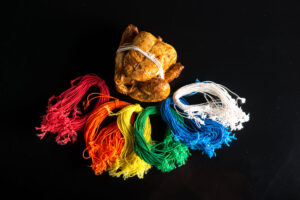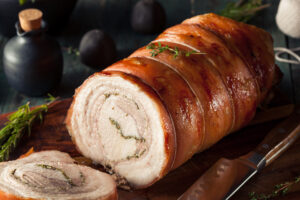What are chicken loops?
Decades ago, supermarkets and poultry processors used to hand-tie their products to keep the legs and wings close to the body to ensure even cooking. It prevents the breast from drying out before the thighs and legs are properly cooked. High costs and a high chance of cross-contamination were the main issues in this process. So, chicken loops were introduced to the poultry industry. The primary advantage of these elastic loops is their ability to increase efficiency, save time, and enhance food safety. Nowadays these loops are being used for other purposes as well, for example, meat tying.

Main applications

The intended use of chicken loops is binding of the poultry legs which facilitates the roasting process. They consist of two or three food grade rubber threads and are covered with cotton or polyester yarns. They are perfect for rotisserie chicken and they can as well be used for tying bacon wrapped filets and many other food preparations. The advantage of the binding rings is that it improves the handling of the product (carcasses can no longer fall open), and therefore avoids damage to the meat.
Our highly automated production process provides chicken loops of high quality and is in accordance with all food safety standards. The loops are easy to use and available in a wide range of different sizes, types and colors to meet your production needs.
Worldwide applications

In Belgium, poultry processors often use labeled chicken loops. The primary purpose of these labels is to increase traceability. However, these labels lead to additional costs and impose higher risks associated with foreign bodies. These labels may give a sense of safety guaranteeing traceability for the consumer, but it is important to carefully consider the pros and cons before using labeled loops.
According to A+ Quality, expert in quality assurance and food safety, the EU Regulation 853/2004, annex II section 1 is clear: “In the case of a package containing cut meat or offal, the identification mark must be affixed to a label attached to the package or printed on the package in such a way that it is destroyed when the package is opened. This is not necessary, however, if the process of opening destroys the packaging.” Pack4Food confirms this after research within their network.


Greenflex and elastic loops
With experience dating back to the 80’s, Greenflex offers these loops to poultry processors worldwide. We combine our inexhaustive technical knowhow with the newest improvements of traceability and food safety. Additionally, we are always looking for improvements of our products based on the needs of our clients. Do you need a custom solution? Our pre-tied elastic loops meet all your packaging demands.
For more information about the Greenflex chicken loops, visit our product page or contact us directly.







